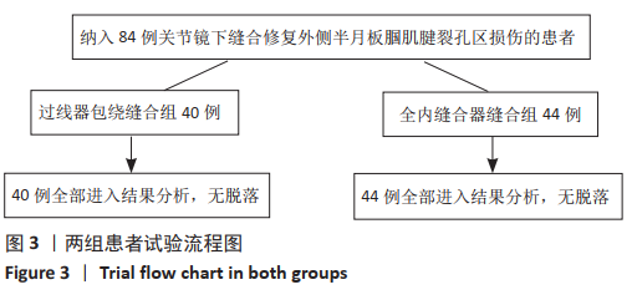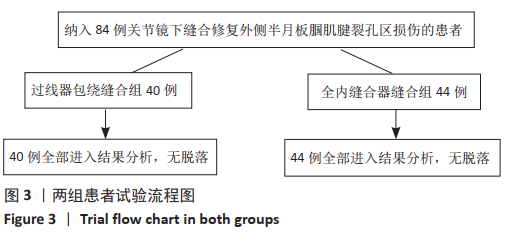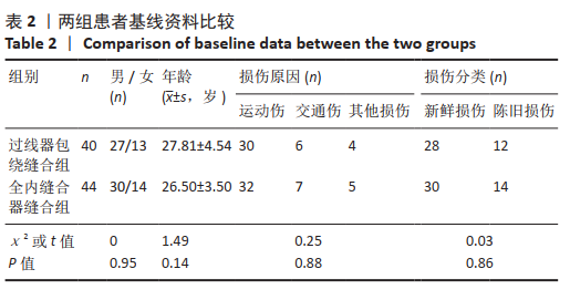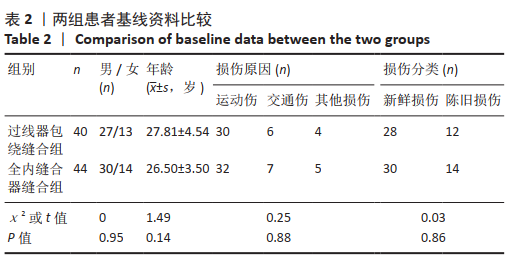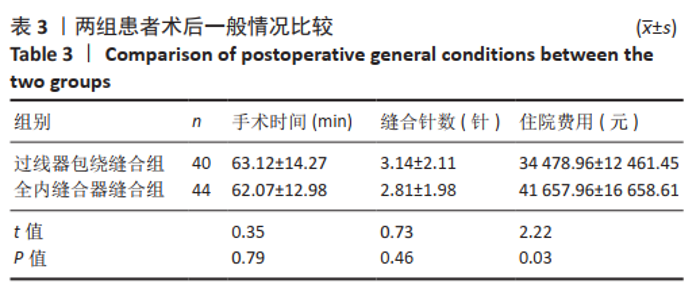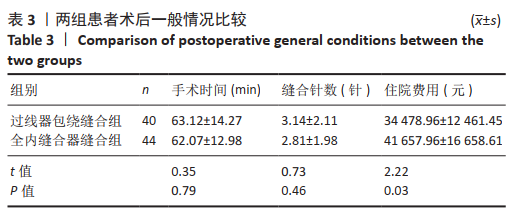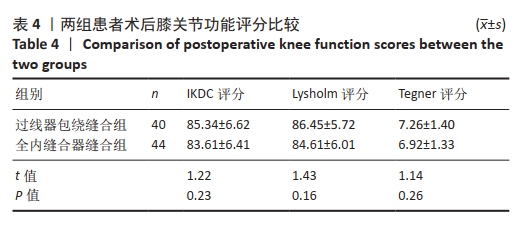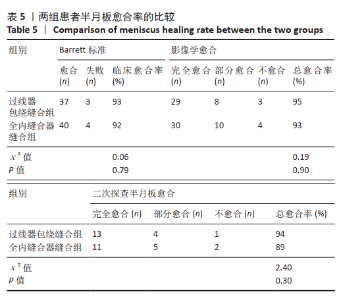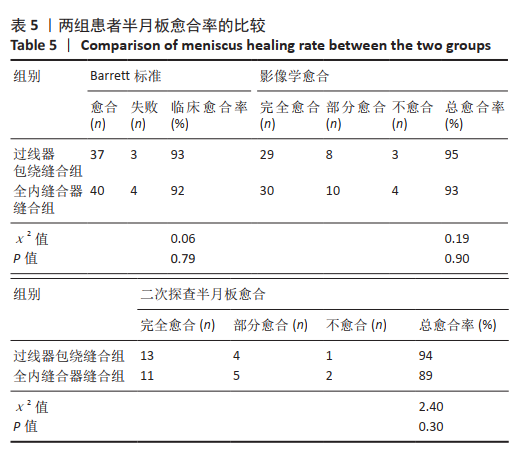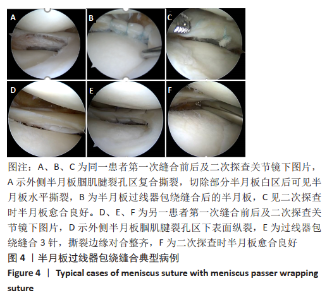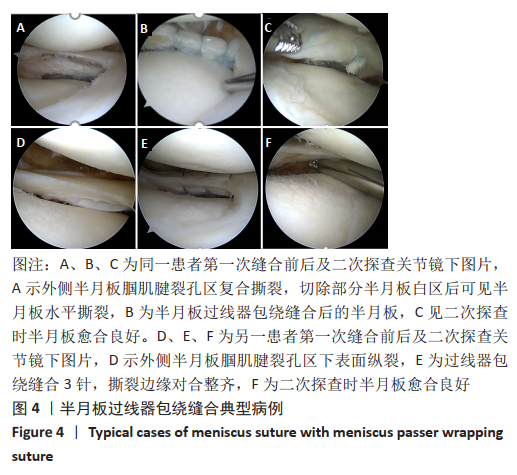[1] 杨远,张凯搏,付维力,等.系统评价运动性半月板损伤的流行病学特征[J].中国组织工程研究,2019,23(31):5079-5084.
[2] MICHALITSIS S, HANTES M, THRISKOS P, et al. Articular cartilage status 2 years after arthroscopic ACL reconstruction in patients with or without concomitant meniscal surgery:evaluation with 3.0T MR imaging. Knee Surg Sports Traumatol Arthrosc. 2017;25(2):437-444.
[3] HIRANAKA T, FURUMATSU T, OKAZAKI Y, et al. Bilateral Anterior Cruciate Ligament Tear Combined with Medial Meniscus Posterior Root Tear. Acta medica Okayama. 2019;73(6):523-528.
[4] EKEN G, MISIR A, DEMIRAG B, et al. Delayed or neglected meniscus tear repair and meniscectomy in addition to ACL reconstruction have similar clinical outcome. Knee Surg Sports Traumatol Arthrosc. 2020;13(3):1452-1456.
[5] GAN ZW, LIE DT, LEE WQ. Clinical outcomes of meniscus repair and partial meniscectomy: Does tear configuration matter? J Orthop Surg (Hong Kong). 2020; 28(1):2309-2312.
[6] COHN AK, MAINS DB. Popliteal hiatus of the lateral meniscus: Anatomy and measurement at dissection of 10 specimens. Am J Sports Med. 1979;7(4):221-226.
[7] SNYDER RL, JANSSON KA. Technical note: peripheral meniscus repairs anterior to the popliteal hiatus. Arthroscopy. 2000;16(8):1-2.
[8] BARRETT GR, TREACY SH, RUFF CH. Preliminary results of the T-fix endoscopic meniscus technique in an anterior cruciate ligament reconstruction population. Arthroscopy. 1997;13(2):218-223.
[9] LYSHOLM J, GILLQUIST J. Evaluation of knee ligament surgery results with special emphasis on use of a scoring scale. Am J Sports Med. 1982;10(3):150-154.
[10] HEFTI F, MÜLLER W, JAKOB RP, et al. Evaluation of knee ligament injuries with the IKDC form. Knee Surg Sports Traumatol Arthrosc. 1993;1(3-4):226-234.
[11] TEGNER Y, LYSHOLM J. Rating systems in the evaluation of knee ligament injuries. Clin Orthop Relat Res. 1985;(198):43-49.
[12] SANDERS TG, MILLER MD. A systematic approach to magnetic resonance imaging interpretation of sports medicine injuries of the knee. Am J Sports Med. 2005; 33(1):131-148.
[13] AHN JH, LEE YS, YOO JC, et al. Clinical and second-look arthroscopic evaluation of repaired medial meniscus in anterior cruciate ligament-reconstructed knees. Am J Sports Med. 2010;38(3):472-477.
[14] AMAN ZS, DEPHILLIPO NN, STORACI HW, et al. Quantitative and Qualitative Assessment of Posterolateral Meniscal Anatomy: Defining the Popliteal Hiatus, Popliteomeniscal Fascicles, and the Lateral Meniscotibial Ligament. Am J Sports Med. 2019;47(8):1797-1803.
[15] 刘广炼,李彩会,邵新中,等.关节镜下半月板成形并腘肌腱裂孔缝合治疗外侧盘状半月板[J].临床误诊误治,2015,28(12):70-72.
[16] BEAUFILS P, PUJOL N. Management of traumatic meniscal tear and degenerative meniscal lesions. Save the meniscus. Orthop Traumatol Surg Res. 2017;103(8): 237-244.
[17] 冯华,洪雷,耿向苏,等.外侧半月板腘肌腱裂孔区损伤的缝合方法[J].中国运动医学杂志,2007,26(2):159-163.
[18] UCHIDA R, MAE T, HIRAMATSU K, et al. Effects of suture site or penetration depth on anchor location in all-inside meniscal repair. Knee. 2016;23(6):1024-1028.
[19] ANDERSON AW, LAPRADE RF. Common peroneal nerve neuropraxia after arthroscopic inside-out lateral meniscus repair. J Knee Surg. 2009;22(1):27.
[20] 吴冰,陆伟,王大平,等.“环抱”缝合法修复内侧半月板桶柄状撕裂中期疗效观察[J].中国修复重建外科杂志,2017,31(3):30-35.
[21] DI GIANCAMILLO A, MANGIAVINI L, TESSARO I, et al. The meniscus vascularization: the direct correlation with tissue composition for tissue engineering purposes. J Biol Regul Homeost Agents. 2016;30(4 Suppl 1):85-90.
[22] FOX AJ, WANIVENHAUS F, BURGE AJ, et al. The human meniscus: a review of anatomy, function, injury, and advances in treatment. Clin Anat. 2015;28(2): 269-287.
[23] 黄刚,陆伟,吴冰,等.关节镜下“环抱”缝合与褥式缝合修复半月板的对比研究[J].深圳中西医结合杂志,2018,28(23):7-11.
[24] OUANEZAR H, BLAKENEY WG, LATROBE C, et al. The popliteus tendon provides a safe and reliable location for all-inside meniscal repair device placement. Knee Surg Sports Traumatol Arthrosc. 2018;26(12):3611-3619.
[25] FANG CH, LIU H, DI ZL, et al. Arthroscopic all-inside repair with suture hook for horizontal tear of the lateral meniscus at the popliteal hiatus region: a preliminary report. BMC Musculoskelet Disord. 2020;21(1):52.
[26] 黄东红,卢启贵,王平,等.关节镜下双面立体缝合修复半月板桶柄状撕裂的中期疗效[J].中国修复重建外科杂志,2015,29(2):163-166. |
